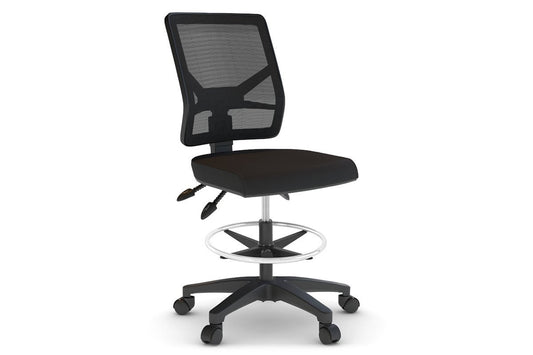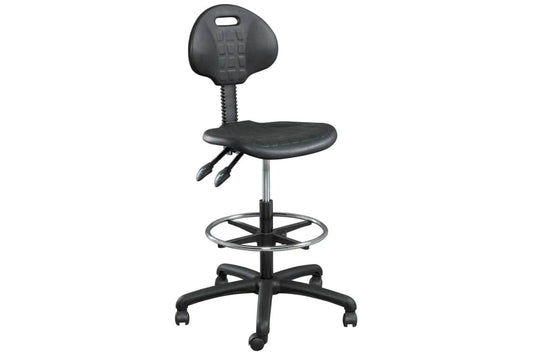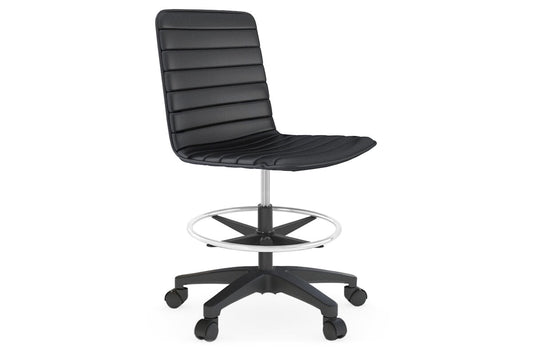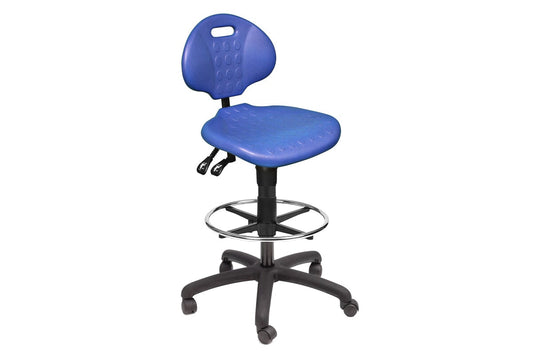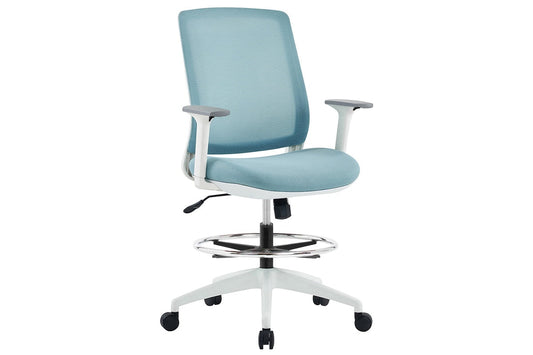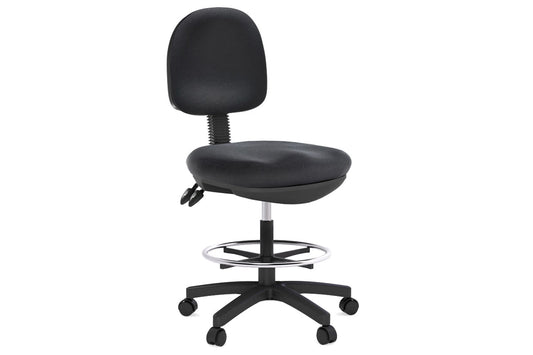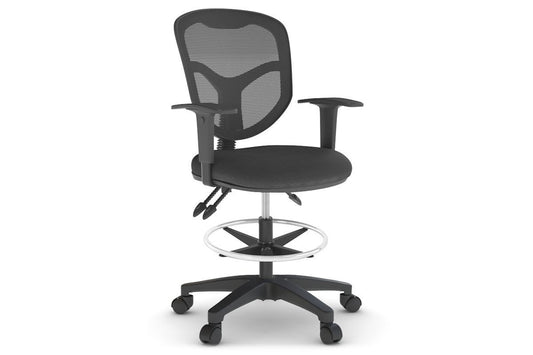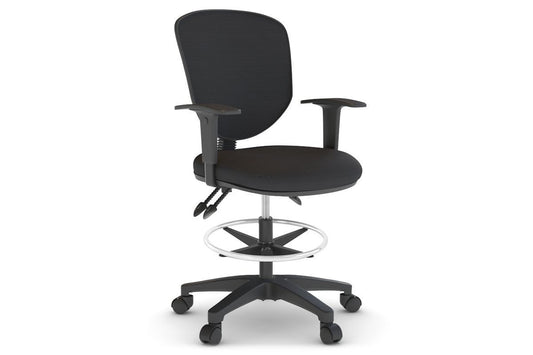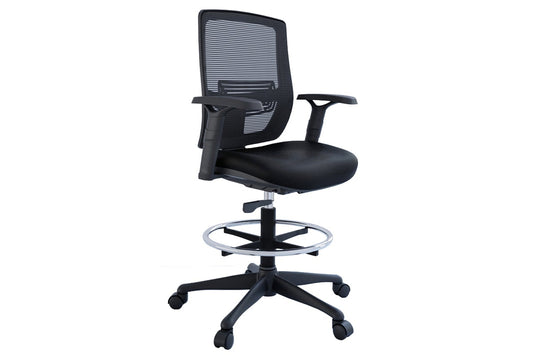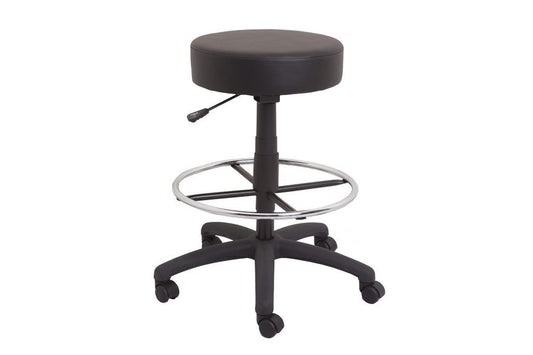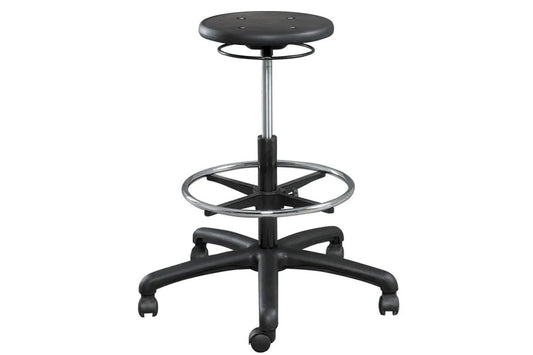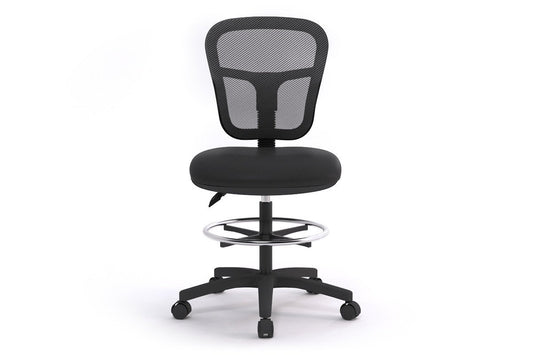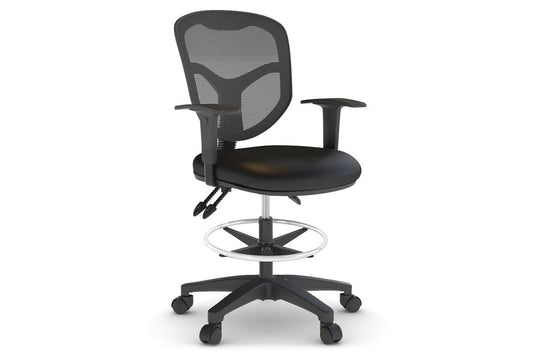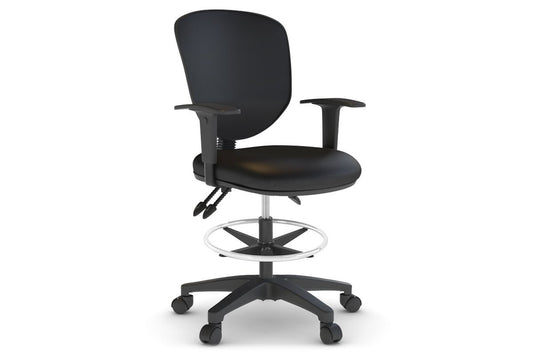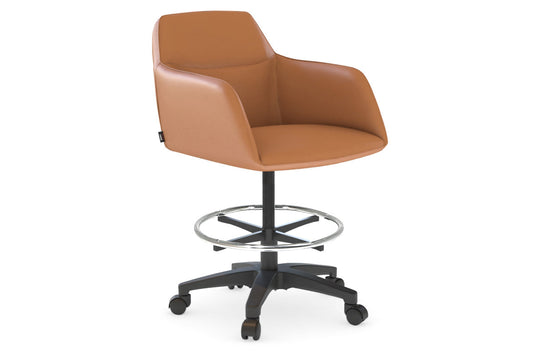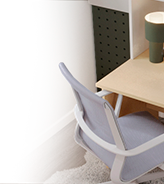Drafting Chair Buying Guide
Embarking on the quest for the perfect drafting chair involves navigating a landscape of ergonomic office furniture considerations, functionality, and design elements. Whether you're an architect, artist, or someone spending extended hours at a drafting table, selecting the right chair is crucial for both comfort and productivity.
In this comprehensive Drafting Chair Buying Guide, we delve into the essential factors to consider when choosing a chair tailored to your specific needs.
From adjustable features that support optimal posture to the durability and style that align with your office space, this guide is your roadmap to informed decision-making. Join us as we explore the intricacies of drafting chairs, empowering you to create a workspace that not only fosters creativity but also prioritizes your well-being.
What is a drafting chair?
A drafting chair, also known as a drafting stool or architect chair, is a specialized type of seating designed for individuals who work at elevated surfaces such as drafting tables, sit standing desk, or counter-height workstations. These chairs are particularly popular in professions that require precision and detail, such as drafting, architecture, graphic design, or any task that involves working at an elevated surface for extended periods.
Key features of drafting chairs include:
-
Height Adjustability:
- Drafting chairs are equipped with height adjustable mechanisms that allow users to set the chair at a comfortable and ergonomic height. This feature ensures that individuals can reach their work surface with ease, whether seated or standing.
-
Footrest:
- Many drafting chairs come with a built-in footrest or a drafting ring around the base, providing support for the feet. This feature helps reduce strain on the legs and promotes proper posture, especially when the chair is set at higher elevations.
-
Swivel and Tilt Functions:
- Drafting chairs often have a swivel function, allowing users to rotate the chair easily to reach different areas of their workspace. Some models also come with a tilting feature that enables the seat to tilt forward or backward, enhancing flexibility and comfort during various tasks.
-
Adjustable Backrest:
- The backrest of a drafting chair is typically adjustable, offering lumbar support and the ability to customize the angle for optimal comfort. This is particularly important for individuals who may spend long hours working on detailed tasks.
-
Durable Materials:
- Drafting chairs are constructed with durability in mind. They often feature sturdy frames, high-quality upholstery, and a stable base to ensure the chair can withstand the demands of a professional workspace.
-
Mobility:
- Many drafting chairs come with casters or wheels that facilitate easy mobility around the workspace. This allows users to move between different areas without the need to stand up.
-
Variety of Styles:
- Drafting chairs come in various styles to cater to different preferences and office aesthetics. Whether you prefer a more traditional design or a modern, sleek look, there are options available to suit your workspace.
Drafting chairs are essential for creating a comfortable and ergonomic work environment for professionals who spend substantial time working at elevated surfaces. The adjustability and specialized features of these chairs contribute to better posture, reduced fatigue, and improved overall well-being for individuals engaged in precision-oriented tasks.
Who is a drafting chair for?
Drafting chairs are designed for individuals who work at elevated surfaces for extended periods, such as drafting tables, standing desks, or counter-height workstations. The primary users of drafting chairs often include professionals and enthusiasts in various fields that require precision, detail, and prolonged focus on tasks. Here are some key groups of people who can benefit from using drafting chairs:
-
Architects and Draftsmen:
- Professionals in architecture and drafting often spend hours sketching, planning, and creating detailed drawings. Drafting chairs provide the necessary support and comfort for these individuals working at elevated drafting tables.
-
Artists and Illustrators:
- Artists and illustrators who work on intricate drawings, illustrations, or graphic design projects can benefit from the ergonomic features of drafting chairs. These chairs provide support for maintaining proper posture during creative sessions.
-
Engineers:
- Engineers working on technical drawings and schematics frequently use drafting chairs to enhance their comfort and productivity. The adjustable height and other ergonomic features accommodate the specific requirements of engineering tasks.
-
Designers:
- Professionals in various design fields, such as industrial design, interior design, or fashion design, often work on drafting tables or workstations. Drafting chairs offer them the flexibility and support needed for extended design sessions.
-
Students and Educators:
- Students pursuing degrees in architecture, design, or engineering, as well as educators in these fields, can benefit from the comfort and adjustability of drafting chairs during lectures, drafting sessions, or collaborative projects.
-
Laboratory Technicians:
- Technicians and researchers working in laboratories may use drafting chairs when conducting experiments, analyzing data, or working at specialized laboratory equipment situated at elevated surfaces.
-
Medical Professionals:
- Some medical professionals, such as surgeons or radiologists, who work at elevated desks or specialized workstations, may use drafting chairs for tasks that require precision and focus.
-
Office Workers with Adjustable Desks:
- In modern office settings with adjustable desks or standing workstations, employees who frequently transition between sitting and standing positions may use drafting chairs to maintain ergonomic support at higher desk heights.
-
Any Professional with a Standing Desk:
- Individuals across various professions who have adopted standing desks can benefit from drafting chairs when they need to sit intermittently. The chairs provide a comfortable seating option at the elevated height of standing desks.
Drafting chairs are versatile tools that cater to the specific needs of individuals who engage in tasks that demand precision and attention to detail. The adjustable features, durability, and ergonomic design make drafting chairs an essential piece of furniture for creating a comfortable and conducive workspace for various professionals and enthusiasts alike.
Features to look for in drafting chairs
When choosing a drafting chair, it's essential to consider features that cater to your specific needs and enhance comfort and productivity, especially for tasks performed at elevated surfaces. Here are key features to look for in drafting chairs:
-
Height Adjustability:
- Opt for a drafting chair with adjustable height to ensure it can be customized to the height of your drafting table or standing desk. A pneumatic or gas lift mechanism allows for easy and precise height adjustments.
-
Footrest or Ring:
- A built-in footrest or a foot ring is crucial for providing support to your legs and promoting proper posture, especially when working at elevated surfaces. Look for a drafting chair with an adjustable footrest to accommodate different user heights.
-
Swivel Function:
- A swivel function allows you to rotate the chair easily, providing access to different areas of your workspace without unnecessary strain. A 360-degree swivel is a common and practical feature.
-
Adjustable Backrest:
- Look for a drafting chair with an adjustable backrest to provide lumbar support. The backrest should offer the ability to recline or tilt, allowing you to find a comfortable position during extended periods of work.
-
Tilt Mechanism:
- Some drafting chairs come with a tilt mechanism that allows the seat to tilt forward or backward. This feature can be particularly beneficial for tasks that require a forward-leaning posture, providing flexibility and comfort.
-
Seat Depth Adjustment:
- The ability to adjust the seat depth ensures that the chair accommodates different body types. It allows you to maintain proper leg support and prevent discomfort during prolonged periods of sitting.
-
Armrests:
- While not essential for everyone, some individuals prefer drafting chairs with adjustable armrests for added support. Choose a chair with armrests that can be adjusted in height or folded away if they are not needed.
-
Casters or Glides:
- Consider the type of flooring in your workspace. If you need to move around frequently, choose a drafting chair with smooth-rolling casters suitable for your flooring type. Alternatively, some chairs come with glides for stability on certain surfaces.
-
Quality Upholstery:
- Opt for a drafting chair with high-quality upholstery that provides comfort and durability. Breathable materials like mesh can be suitable for enhanced airflow, especially in longer work sessions.
-
Stability and Weight Capacity:
- Ensure that the drafting chair is stable and has a weight capacity that meets your requirements. A stable five-point base with a sturdy frame contributes to the chair's overall stability.
-
Durability and Construction:
- Look for drafting chairs made from durable materials, such as steel or aluminum frames. Quality construction ensures that the chair can withstand the demands of a professional workspace over time.
-
Easy Assembly:
- Consider a drafting chair that is easy to assemble, with clear instructions provided. This can save time and ensure a hassle-free setup in your workspace.
-
Style and Aesthetics:
- While functionality is key, consider the style and aesthetics of the drafting chair to complement your workspace. Choose a design that aligns with your preferences and the overall decor of your office.
By carefully considering these features, you can select a drafting chair that not only meets your ergonomic needs but also enhances your overall comfort and well-being during tasks performed at elevated surfaces.
The benefits of ergonomic drafting chairs
Ergonomic drafting chairs offer a multitude of benefits, enhancing comfort, productivity, and overall well-being for individuals engaged in tasks that require precision and extended periods of sitting or standing. Here are some key advantages of using ergonomic drafting chairs:
-
Optimal Height Adjustment:
- Ergonomic drafting chairs are designed with adjustable height features, allowing users to customize the chair to the specific height of their drafting table or standing desk. This ensures proper alignment and reduces the risk of discomfort or strain.
-
Improved Posture Support:
- These chairs are equipped with features such as lumbar support, adjustable backrests, and seat tilt mechanisms, promoting proper posture. Maintaining a neutral spine position is essential for preventing back pain and discomfort during long work sessions.
-
Reduced Fatigue and Discomfort:
- The ergonomic design of office drafting chairs minimizes fatigue and discomfort associated with prolonged sitting or standing. Features like seat depth adjustment, supportive backrests, and footrests contribute to a more comfortable and supportive working environment.
-
Enhanced Blood Circulation:
- By providing proper support and encouraging dynamic movement, ergonomic drafting chairs contribute to improved blood circulation. This helps prevent numbness, tingling, and potential health issues associated with poor circulation.
-
Increased Productivity:
- Comfortable and ergonomic seating positively impacts productivity. Users are less likely to experience distractions or interruptions due to discomfort, allowing for sustained focus and efficiency in completing tasks.
-
Flexibility and Mobility:
- Many ergonomic drafting chairs come with swivel functions and smooth-rolling casters, enhancing flexibility and mobility around the workspace. This adaptability is particularly beneficial for individuals who need to access different areas while working.
-
Customization for Individual Needs:
- Ergonomic drafting chairs often offer a range of adjustable features, such as armrests, footrests, and lumbar support, allowing users to customize the chair to their specific needs and preferences. This adaptability caters to diverse body types and work requirements.
-
Support for Standing Workstations:
- For individuals using standing desks, ergonomic drafting chairs with height adjustability provide a comfortable seating option when a break from standing is needed. This versatility accommodates different working positions throughout the day.
-
Prevention of Musculoskeletal Issues:
- Ergonomic drafting chairs are designed to minimize the risk of musculoskeletal issues such as back pain, neck strain, and shoulder discomfort. Proper support and alignment contribute to the overall health and well-being of users.
-
Long-Term Health Benefits:
- Investing in ergonomic seating contributes to long-term health benefits. By promoting good posture and reducing the impact of prolonged sitting or standing, ergonomic drafting chairs play a crucial role in preventing chronic health issues associated with poor workplace ergonomics.
-
Employee Satisfaction and Retention:
- Providing employees with ergonomic seating options demonstrates a commitment to their well-being, contributing to higher job satisfaction and potential employee retention. Comfortable and supportive seating is often appreciated and valued by individuals in a professional setting.
In conclusion, ergonomic drafting chairs go beyond mere seating solutions—they are integral to creating a workspace that prioritizes health, comfort, and productivity. Whether you're an architect, artist, designer, or any professional requiring precision in your work, investing in an ergonomic drafting chair can significantly enhance your overall work experience.
Are drafting chairs and drafting stools the same thing?
While the terms "drafting chair" and "drafting stool" are often used interchangeably, there are subtle differences in their typical designs and features.
Drafting Chair:
- A drafting chair typically resembles a traditional office chair but is designed with additional height to accommodate drafting tables, standing desks, or elevated work surfaces. It often comes with a five-point base, casters for mobility, and a full range of ergonomic features, such as adjustable height, lumbar support, and a tilting mechanism. Drafting chairs usually offer a higher level of back support compared to stools.
Drafting Stool:
- A drafting stool, on the other hand, tends to have a simpler design with a focus on providing a raised seating option. It may have a smaller, more compact seat and lacks a full backrest. Drafting stools often feature a footring or footrest to support the legs and feet when seated at an elevated surface. They are designed to offer a more open and dynamic seating experience, allowing for easy movement and access to various work angles.
In essence, the main distinction lies in the level of back support and the overall design. Drafting chairs typically offer more comprehensive ergonomic features and back support, making them suitable for tasks requiring extended periods of sitting. Drafting stools, with their simpler design, are often chosen for workspaces where users may need to move around frequently or prefer a more open and dynamic seating arrangement.
Ultimately, the choice between a drafting chair and a drafting stool depends on individual preferences, the nature of the tasks performed, and the level of ergonomic support desired in a particular workspace.
What are the differences between drafting chairs and task chairs?
Drafting chairs and task chairs are both designed for office environments, but they cater to different needs and work setups. Here are the key differences between drafting chairs and task chairs:
1. Height:
- Drafting Chairs: These chairs are taller and designed for use with drafting tables, standing desks, or elevated work surfaces. They have a higher seat height compared to standard office chairs.
- Task Chairs: Task chairs have a standard seat height suitable for regular desks or workstations. They are not as tall as drafting chairs.
2. Design:
- Drafting Chairs: Typically, drafting chairs have a longer cylinder or a height extension to accommodate the elevated surfaces. They may also have a footrest or footring to support the feet when sitting at higher levels.
- Task Chairs: Task chairs have a more traditional design with a focus on providing comfort for standard desk heights. They often have a five-point base with casters for mobility.
3. Back Support:
- Drafting Chairs: Drafting chairs often come with a full backrest, providing comprehensive support for the user. The backrest may be adjustable in terms of height and tilt to accommodate different preferences.
- Task Chairs: Task chairs also come with a backrest, but the design can vary. Some task chairs have a high back for full spinal support, while others may have a mid-back or low-back design.
4. Functionality:
- Drafting Chairs: Designed for tasks that involve precision and detail, drafting chairs often come with ergonomic features such as lumbar support, adjustable armrests, and a tilting mechanism.
- Task Chairs: Task chairs are versatile and can be found in a range of designs to suit various office settings. They may include ergonomic features but are generally more standardized compared to drafting chairs.
5. Use Cases:
- Drafting Chairs: Ideal for professions such as architecture, drafting, graphic design, or any task that requires working at elevated surfaces for extended periods.
- Task Chairs: Suitable for a wide range of office settings and professions where the work is primarily done at a standard desk height.
6. Mobility:
- Drafting Chairs: Drafting chairs may or may not have casters, depending on the specific design. Some come with glides instead of casters for stability.
- Task Chairs: Task chairs typically have casters, allowing for easy mobility within the workspace.
In summary, the main differences between drafting chairs and task chairs lie in their height, design, and intended use. Drafting chairs are tailored for tasks performed at elevated surfaces, while task chairs are designed for standard desk heights in diverse office environments. The choice between the two depends on the nature of the work and the specific ergonomic requirements of the user.
What are the differences between drafting chairs and lab stools?
Drafting chairs and lab stools serve distinct purposes in different work environments, particularly in settings like laboratories. Here are the key differences between drafting chairs and lab stools:
1. Purpose and Setting:
- Drafting Chairs: Primarily designed for tasks that require precision and detail, drafting chairs are often used in offices, design studios, or any workspace where individuals work at elevated surfaces like drafting tables or standing desks.
- Lab Stools: Lab stools are specifically designed for laboratory environments where researchers and technicians engage in scientific experiments and analyses. They are suitable for use at lab benches, workstations, or other laboratory surfaces.
2. Height and Design:
- Drafting Chairs: Drafting chairs have an adjustable height feature to accommodate various elevated work surfaces. They often come with a footrest or footring to support the legs when sitting at higher levels. The design may include a full backrest for ergonomic support.
- Lab Stools: Lab stools typically have a fixed height, as they are intended for use at standard laboratory workbenches. The design may include a simple seat without a full backrest to facilitate easy movement and access to lab equipment.
3. Mobility and Stability:
- Drafting Chairs: Some drafting chairs come with casters for mobility, allowing users to move around within the workspace. Others may have glides for stability, especially in settings where mobility is not a priority.
- Lab Stools: Lab stools often have glides rather than casters to provide stability on potentially slippery laboratory floors. The emphasis is on preventing unwanted movement during delicate experiments.
4. Materials and Cleanability:
- Drafting Chairs: Drafting chairs come in a variety of materials, including fabric, mesh, or leather upholstery. The materials used may prioritize comfort and aesthetics. Cleanability is essential but may not be as critical as in a laboratory setting.
- Lab Stools: Lab stools are often constructed with materials that prioritize durability and ease of cleaning. They may have seats made of materials resistant to chemicals and spills, ensuring a hygienic and safe environment in a lab.
5. Ergonomic Features:
- Drafting Chairs: Drafting chairs are designed with comprehensive ergonomic features such as lumbar support, adjustable armrests, and tilting mechanisms. These features aim to provide comfort during extended periods of detailed work.
- Lab Stools: While some lab stools may have basic ergonomic considerations, such as a contoured seat for comfort, they generally prioritize simplicity and ease of movement over extensive ergonomic features.
6. Use in Other Settings:
- Drafting Chairs: Drafting chairs are versatile and can be used in various settings beyond drafting or design studios. They may find applications in offices, art studios, or any workspace with elevated surfaces.
- Lab Stools: Lab stools are specialized for laboratory use and may not be as versatile in other office or work environments.
In summary, drafting chairs are designed for tasks that require precision and detail at elevated surfaces, while lab stools are tailored for laboratory settings, emphasizing stability, durability, and cleanability. The choice between the two depends on the specific needs and requirements of the work environment.
Can I use a drafting chair as a technician chair?
Yes, you can use a drafting chair as a technician chair in certain settings, depending on the specific requirements of the work environment and the tasks involved. Drafting chairs are designed to provide ergonomic support for individuals working at elevated surfaces, making them suitable for various professions, including technicians. Here are some considerations:
1. Elevated Work Surfaces:
- If the technician's workstation involves elevated surfaces, such as workbenches, standing desks, or lab benches, a drafting chair's adjustable height feature can be beneficial. It allows the technician to customize the chair's height to comfortably reach the work surface.
2. Comfort and Ergonomics:
- Drafting chairs typically offer ergonomic features such as lumbar support, adjustable backrests, and sometimes, footrests. These features contribute to the overall comfort of the technician during extended periods of work.
3. Mobility:
- Some drafting chairs come with casters for easy mobility, allowing technicians to move around within the workspace. This can be advantageous in environments where flexibility and accessibility are important.
4. Adjustable Features:
- Drafting chairs often come with a range of adjustable features, including seat height, backrest height, and tilt mechanisms. These features allow technicians to customize the chair to their preferences and ergonomic needs.
5. Versatility:
- Drafting chairs are versatile and can be used in various work settings, not just drafting or design studios. If the technician's tasks involve a combination of sitting and standing or if they work at different workstations, a drafting chair can provide flexibility.
6. Cleanability:
- Consider the ease of cleaning, especially in environments where spills or contaminants may be a concern. Some drafting chairs come with materials that are easy to clean, making them suitable for environments where cleanliness is a priority.
7. Task Specificity:
- Assess the specific tasks performed by the technician. If the tasks involve precision work or detailed inspections at an elevated surface, a drafting chair may be well-suited. However, if the tasks primarily involve sitting at a standard desk, a task chair may be more appropriate.
It's essential to evaluate the specific needs of the technician's job and the characteristics of the work environment. While drafting chairs can be versatile and adaptable, they may not be the best fit for every scenario. If possible, try to match the chair to the specific tasks and ergonomic requirements of the technician to ensure optimal comfort and efficiency in their work.
Medium back drafting chairs
Medium back drafting chairs combine the features of drafting chairs with a mid-level backrest, providing ergonomic support while maintaining a more open and dynamic seating experience. Here are some key characteristics and benefits of medium back drafting chairs:
-
Moderate Back Support:
- Medium back drafting chairs offer a backrest that extends to the mid-level of the user's back. While not as tall as high-back chairs, they still provide sufficient lumbar support for comfort during extended periods of sitting.
-
Versatility:
- These chairs are versatile and suitable for various work environments, including offices, design studios, and workstations with elevated surfaces. They offer a balance between back support and the freedom of movement.
-
Elevated Height:
- Like traditional drafting chairs, medium back drafting chairs have an adjustable height feature, allowing users to customize the chair to the height of their drafting table, standing desk, or other elevated work surfaces.
-
Footrest or Footring:
- Many medium back drafting chairs come equipped with a footrest or footring to support the feet and legs when sitting at higher levels. This feature contributes to maintaining proper posture and reducing strain.
-
Mobility:
- Depending on the design, medium back drafting chairs may come with casters for easy mobility within the workspace. This enhances flexibility, allowing users to move around without the need to stand up frequently.
-
Dynamic Seating:
- The mid-back design encourages a more open and dynamic seating experience. Users can easily turn and reach different areas of their workspace without the hindrance of a higher backrest.
-
Adjustable Features:
- These chairs typically offer a range of adjustable features, such as seat height adjustment, backrest height adjustment, and sometimes, tilt mechanisms. Users can customize the chair to their ergonomic preferences.
-
Task Versatility:
- Medium back drafting chairs are well-suited for tasks that involve a combination of sitting and standing. They are adaptable to various work scenarios, making them suitable for professionals who need flexibility in their workstations.
-
Aesthetics:
- The mid-back design often contributes to a more modern and open aesthetic. It can seamlessly integrate into different office or studio environments, complementing a variety of design styles.
-
Comfortable for Extended Use:
- With moderate back support and ergonomic features, medium back drafting chairs are designed for prolonged use. They provide a comfortable and supportive seating option for individuals engaged in tasks that demand precision and focus.
Whether you're an architect, designer, or anyone working at an elevated surface, a medium back drafting chair could be an excellent choice. It provides the benefits of back support while allowing for easy movement and adaptability in diverse work settings.
Heavy duty drafting chairs
Heavy-duty drafting chairs are designed to accommodate individuals who require a sturdier and more robust seating solution, often characterized by a higher weight capacity and durable construction. These chairs are suitable for various professional settings, particularly for those engaged in tasks that demand precision and focus at elevated work surfaces. Here are key features and considerations for heavy-duty drafting chairs:
1. High Weight Capacity:
- Heavy-duty drafting chairs are built with a higher weight capacity compared to standard chairs. This ensures stability and durability, accommodating users with varying body types.
2. Sturdy Construction:
- The frame and base of heavy-duty drafting chairs are constructed with reinforced materials such as steel or aluminum. This robust construction enhances the chair's overall strength and stability.
3. Durable Upholstery:
- The upholstery of heavy-duty drafting chairs is designed to withstand wear and tear. Materials chosen for durability and easy cleaning contribute to the longevity of the chair.
4. Adjustable Height:
- Like standard drafting chairs, heavy-duty versions come with adjustable height features. This allows users to customize the chair to the height of their drafting table, standing desk, or other elevated work surfaces.
5. Footrest or Footring:
- To provide additional support for users with higher seating requirements, heavy-duty drafting chairs often come with a substantial footrest or footring. This feature contributes to maintaining proper posture and reducing strain on the legs.
6. Wide and Padded Seat:
- Heavy-duty drafting chairs typically feature a wider and more generously padded seat to enhance comfort for users with larger body sizes.
7. Lumbar Support:
- Lumbar support is an important feature in heavy-duty drafting chairs to promote proper spinal alignment and reduce the risk of back discomfort during extended periods of sitting.
8. Tilt Mechanism:
- Some heavy-duty drafting chairs may include a tilt mechanism in the seat or backrest for added flexibility and comfort. This feature allows users to adjust the angle of the chair to suit their preferences.
9. Mobility:
- Depending on the design, heavy-duty drafting chairs may come with heavy-duty casters or glides to ensure smooth mobility within the workspace. Casters are particularly beneficial if the user needs to move around frequently.
10. Versatility: - Heavy-duty drafting chairs are versatile and can be used in a variety of professional settings, including drafting studios, laboratories, workshops, and offices where durability and strength are essential.
11. Easy Maintenance: - The materials used in heavy-duty drafting chairs are often chosen for easy maintenance and cleaning. This is especially important in environments where spills or contaminants may occur.
Whether you're a professional in drafting, design, or any field that requires extended periods of focused work, a heavy-duty drafting chair ensures that you have a sturdy and reliable seating solution that meets the demands of your work environment and body size.
Mesh chairs: Can I buy a drafting chair with a mesh back?
Yes, you can certainly find drafting chairs with a mesh back. Mesh-backed drafting chairs combine the ergonomic features of drafting chairs with the breathability and comfort of a mesh backrest. Here are some key considerations and benefits of opting for a drafting chair with a mesh back:
-
Breathability:
- Mesh-backed chairs allow for better airflow, keeping you cool and comfortable during extended periods of sitting. This feature is particularly advantageous in environments where temperature control is essential.
-
Ergonomic Support:
- Mesh backrests are designed to conform to the natural curves of the spine, providing ergonomic support to the lumbar region. This helps maintain proper posture and reduces the risk of back discomfort during long work sessions.
-
Adjustability:
- Many mesh-backed drafting chairs come with adjustable features, including height adjustment, tilt mechanisms, and lumbar support adjustments. These features allow you to customize the chair to your specific ergonomic preferences.
-
Flexibility and Movement:
- The flexibility of a mesh back allows for dynamic movement and easy adjustments. This is beneficial for individuals who need to reach different areas of their workspace or shift between sitting and standing positions.
-
Lightweight Design:
- Mesh-backed chairs are often lighter in weight compared to chairs with solid backrests. This can be advantageous if you need to move the chair around or if mobility is a priority in your workspace.
-
Modern Aesthetics:
- Mesh-backed drafting chairs often have a modern and contemporary appearance. The sleek and breathable design can complement various office or studio aesthetics.
-
Cleaning and Maintenance:
- Mesh materials are generally easy to clean and maintain. Spills or stains can be addressed with simple cleaning methods, making mesh-backed drafting chairs a practical choice in environments where cleanliness is important.
-
Versatility:
- Mesh-backed drafting chairs are versatile and suitable for various work settings, including drafting studios, offices, and collaborative workspaces. Their adaptability makes them a popular choice among professionals.
When selecting a mesh-backed drafting chair, consider factors such as the chair's weight capacity, adjustability features, and the overall design to ensure it meets your specific needs and preferences. With the combination of mesh comfort and drafting chair functionality, you can create a conducive and ergonomic workspace tailored to your requirements.
Browse our AFRDI certified range of drafting chairs
We take great pride in creating ergonomic drafting chairs with professional draftsmen in mind. Most of our chairs are AFRDI certified so you can be sure you're getting only the highest quality chairs across Australia at JasonL.


